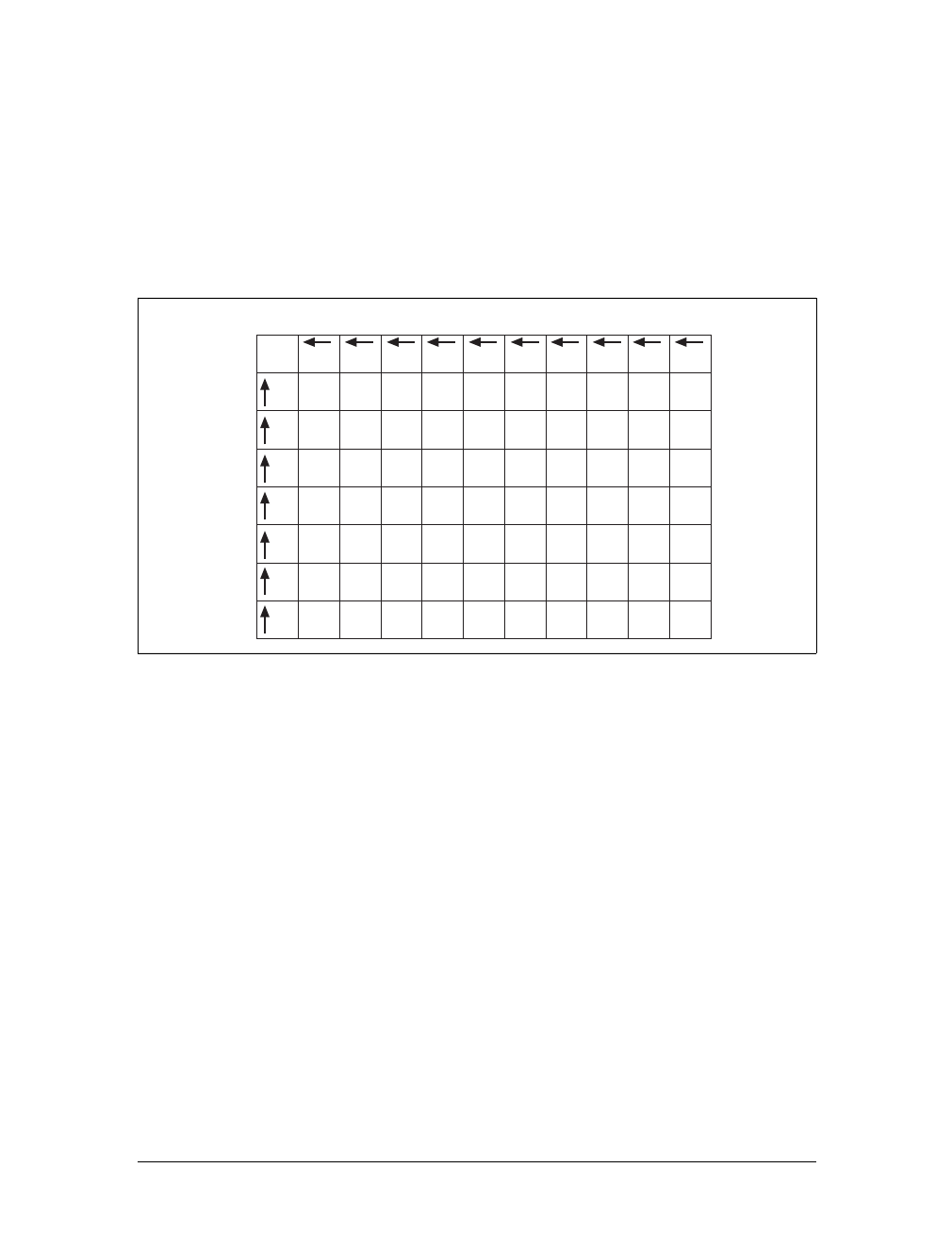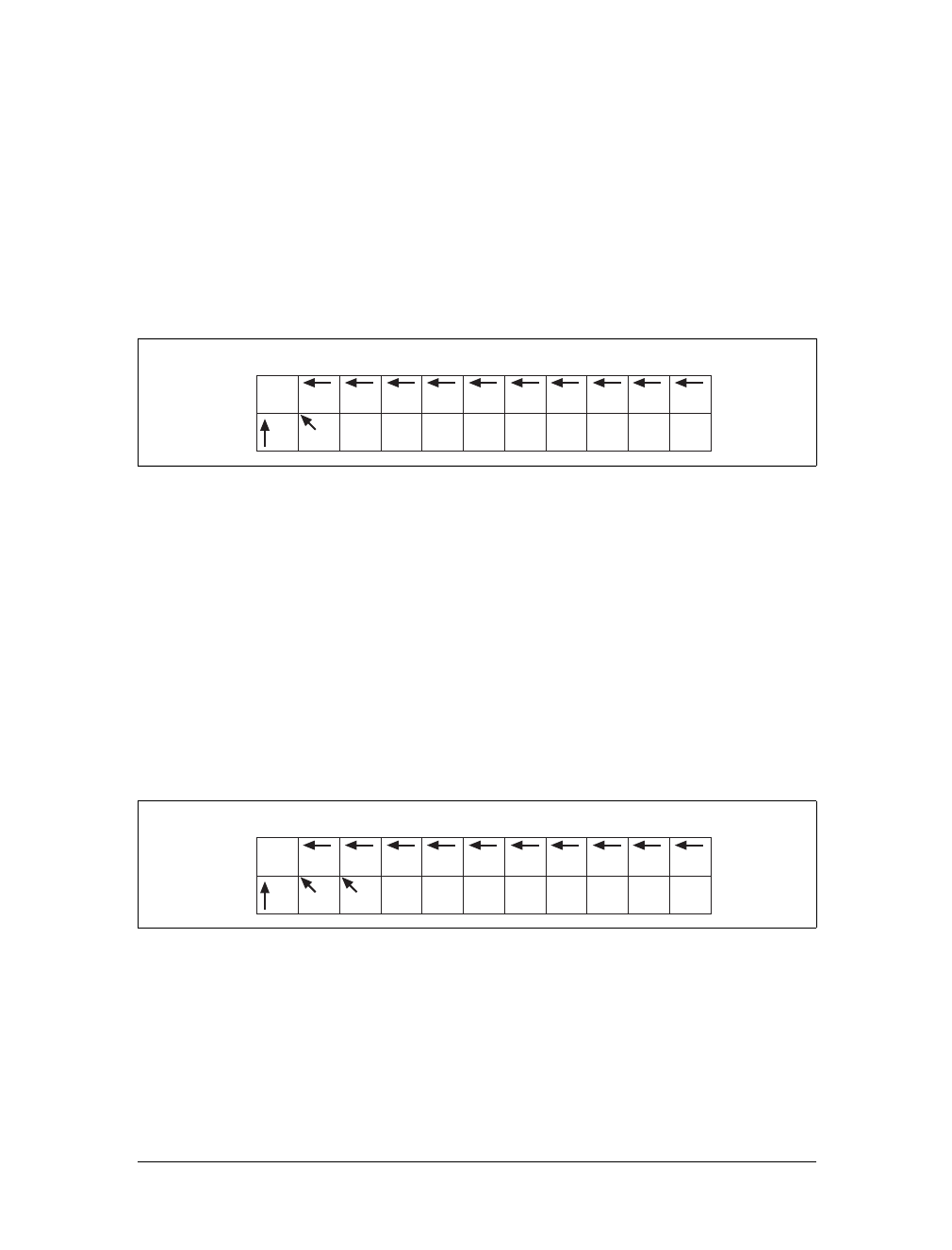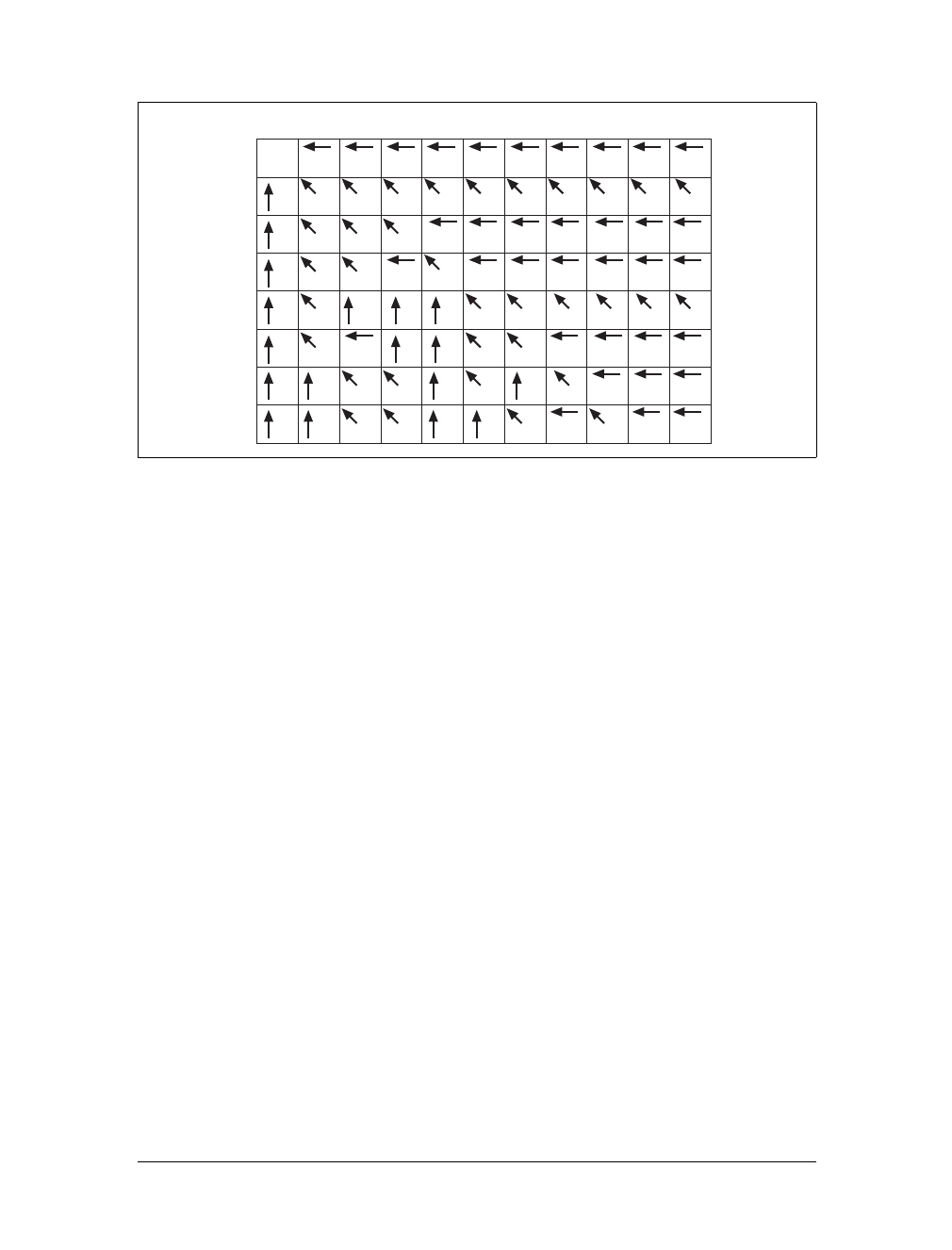
This is the Title of the Book, eMatter Edition
Copyright © 2012 O’Reilly & Associates, Inc. All rights reserved.
40
Chapter 3
CHAPTER 3
Sequence Alignment
BLAST finds statistically significant similarities between sequences by evaluating
alignments, but how are sequences aligned? In principle, there are many ways to align
two sequences, but in practice, one method is used more often than any other. This
chapter explains this technique with the biologist in mind, without using the mathe-
matical notation and jargon that is usually employed to describe such algorithm.
Divested of unfamiliar language and notation, these algorithms are quite simple.
Finding the optimal alignment between two sequences can be a computationally
complex task. Fortunately, a technique called dynamic programming (DP) makes
sequence alignment tractable as long as you follow a few rules. Rather than have you
struggle with a confusing definition of DP, this chapter demonstrates how the tech-
nique works for sequence alignment and then gets back to the generalities. There are
fundamentally two kinds of alignment: global and local. In global alignment, both
sequences are aligned along their entire lengths and the best alignment is found. In
local alignment, the best subsequence alignment is found. For example, if you want
to find the two most similar sentences between two books, you use local alignment.
If you want to compare the sentences end to end, use global alignment. This chapter
describes global alignment, then local alignment. The example uses English words
instead of biological sequences and the algorithms are quite general.
Global Alignment: Needleman-Wunsch
The global alignment algorithm described here is called the Needleman-Wunsch
algorithm. We will explain it in a way that seems natural to biologists, that is, it tells
the end of the story first, and then fills in the details. (This is why biologists make
terrible comedians; they always tell the punch line first.) We will align the words
COELANCANTH and PELICAN using a simple scoring scheme: +1 for letters that
match, –1 for mismatches, and –1 for gaps. The alignment will eventually look like
one of the following, which are equivalent given our scoring scheme:

This is the Title of the Book, eMatter Edition
Copyright © 2012 O’Reilly & Associates, Inc. All rights reserved.
Global Alignment: Needleman-Wunsch
|
41
COELACANTH COELACANTH
P-ELICAN-- -PELICAN--
Note that every letter of each sequence is aligned to a letter or a gap. In local align-
ments, discussed later, this isn’t the case.
The alignment takes place in a two-dimensional matrix in which each cell corre-
sponds to a pairing of one letter from each sequence. To get an intuitive understand-
ing of the alignment algorithm, look at Figure 3-1, which shows where the maximum
scoring alignment lies in the matrix. The alignment starts at the upper left and fol-
lows a mostly diagonal path down and to the right. When two letters are aligned, the
path follows a diagonal trajectory. There are several places in which the letters from
COELACANTH are paired to gap characters. In this case, the graph is followed hori-
zontally. Although not shown here, the path may be also be followed vertically when
the letters from PELICAN are paired with gap characters. Gap characters can never
be paired to each other. Note that the first row and column are blank. The reason for
this will become clear shortly.
In reality, you don’t store letters in the matrix as shown in Figure 3-1. Each cell of
the matrix actually contains two values: a score and a pointer. The score is derived
from the scoring scheme. Here, this means +1 or –1, but when aligning biological
sequences, the values come from a scoring matrix (a topic of the next chapter). The
pointer is a directional indicator (an arrow) that points up, left, or diagonally up and
left. The pointer navigates the matrix, and its use will become clearer later in the
chapter. Now, let’s look at the algorithm in detail. There are three major phases: ini-
tialization, fill, and trace-back.
Figure 3-1. Example of an alignment matrix
P
E
L
I
C
A
N
COELACANTH
C
P
0
E
E
L
L
A
I
C
C
A
A
N
N
T
–
H
–

This is the Title of the Book, eMatter Edition
Copyright © 2012 O’Reilly & Associates, Inc. All rights reserved.
42
|
Chapter 3: Sequence Alignment
Initialization
In the initialization phase, you assign values for the first row and column
(Figure 3-2). The next stage of the algorithm depends on this. The score of each cell
is set to the gap score multiplied by the distance from the origin. Gaps may be
present at the beginning of either sequence, and their cost is the same as anywhere
else. The arrows all point back to the origin, which ensures that alignments go all the
way back to the origin (a requirement for global alignment).
Fill
In the fill phase (also called induction), the entire matrix is filled with scores and
pointers using a simple operation that requires the scores from the diagonal, vertical,
and horizontal neighboring cells. You will compute three scores: a match score, a
vertical gap score, and a horizontal gap score. The match score is the sum of the diag-
onal cell score and the score for a match (+1 or –1). The horizontal gap score is the
sum of the cell to the left and the gap score (–1), and the vertical gap score is com-
puted analogously. Once you’ve computed these scores, assign the maximum value
to the cell and point the arrow in the direction of the maximum score. Continue this
operation until the entire matrix is filled, and each cell contains the score and pointer
to the best possible alignment at that point.
If you look at the initialized matrix, you’ll find that there’s only one cell where you
can compute the maximum score because there’s only one cell with the required 3
neighbors. Now you can see why you needed to leave one extra column and row and
why you needed the initialization phase. Without them, you wouldn’t be able to
Figure 3-2. Initialization of the alignment matrix
P
E
L
I
C
A
N
COELACANTH
-1
-2
-3
-4
-5
-6
-7
-1 -2 -3 -4 -5 -6 -7 -8 -9 -100

This is the Title of the Book, eMatter Edition
Copyright © 2012 O’Reilly & Associates, Inc. All rights reserved.
Global Alignment: Needleman-Wunsch
|
43
start the fill. Ignoring the rest of the table, compute this cell (the one that matches C
to P).
The match score is the sum of the preceding diagonal cell (score = 0) and the score
for aligning C to P (–1). The total match score is –1. The horizontal gap score is the
sum of the score to the left (–1) and the gap score (–1). The horizontal gap score is
therefore –2. The same is true for the vertical gap score. Your maximum score is
therefore the diagonal score (–1), and the pointer is set to the diagonal (Figure 3-3).
Now that this first cell is computed, you can compute the cell to the right or the cell
below. Calculate one more cell, the right neighbor (the one that aligns O and P).
The match score is the sum of the preceding diagonal cell (–1) and the mismatch
score (–1), which equals –2. The horizontal gap score is the score of the cell to the
left (–1) and the gap penalty (–1), which is also –2. The vertical gap score is the cell
above (–2) and the gap penalty (–1), which totals –3. The maximum score is –2, but
this can come from the diagonal or from the left. This is where you must make a con-
sistent, arbitrary choice—for example, always choose the diagonal over a gap.
The matrix up to this point is shown in Figure 3-4. It may seem rather trivial, but the
maximum global alignment between CO and P can be calculated. It has a score of –2
and has either of the following equivalent forms:
CO CO
-P P-
Using the same maximizing procedure for each cell, you can fill the entire matrix. At
the end of the fill, the matrix appears as in Figure 3-5.
Figure 3-3. Beginning to fill the alignment matrix
Figure 3-4. Second cell filled in the alignment matrix
P
COELACANTH
-1
-1 -2 -3 -4 -5 -6 -7 -8 -9 -100
-1
P
COELACANTH
-1
-1 -2 -3 -4 -5 -6 -7 -8 -9 -100
-1 -2

This is the Title of the Book, eMatter Edition
Copyright © 2012 O’Reilly & Associates, Inc. All rights reserved.
44
|
Chapter 3: Sequence Alignment
Trace-Back
The trace-back lets you recover the alignment from the matrix. Like the other parts
of this algorithm, it’s pretty simple. Start at the bottom-right corner and follow the
arrows until you get to the beginning. To produce the alignment, at each cell, write
out the corresponding letters or a hyphen for the gap symbol. Since you’re following
it from the end to the start, the alignment will be backward, and you just reverse it.
The final alignment looks like this:
COELACANTH
-PELICAN-
Example 3-1 shows a Perl script.
Figure 3-5. Filled alignment matrix
Example 3-1. Trace-back with Needleman-Wunsch algorithm
# Needleman-Wunsch Algorithm
# usage statement
die "usage: $0 <sequence 1> <sequence 2>
" unless @ARGV == 2;
# get sequences from command line
my ($seq1, $seq2) = @ARGV;
# scoring scheme
my $MATCH = 1; # +1 for letters that match
my $MISMATCH = -1; # -1 for letters that mismatch
my $GAP = -1; # -1 for any gap
# initialization
my @matrix;
P
E
L
I
C
A
N
COELACANTH
-1
-2
-3
-4
-5
-6
-7
-1 -2 -3 -4 -5 -6 -7 -8 -9 -100
-1 -2 -3 -4 -5 -6 -7 -8 -9 -10
-2 -2 -1
-3 -3
-2
-5 -5
-4 -5
-4
-3 -4
-4
-2
-3
-4
-0 -8
-6
-6
-4
-2
-0
-7
-5
-5
-3
-1
-1
-6
-4
-4
-2
-0
-5
-3
-1
-1
-0
-4-3
-2-1
-2-1
-1
-0-2
-2
-1-1
-5 -4
-4 -3
-2 -2 -2
-1
..................Content has been hidden....................
You can't read the all page of ebook, please click here login for view all page.
